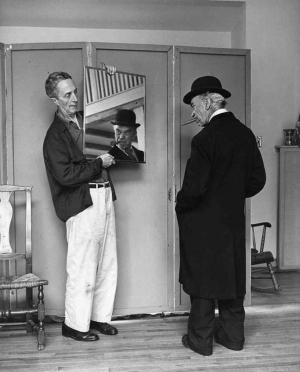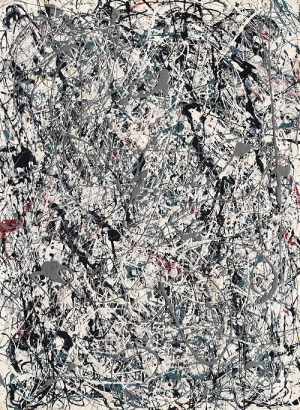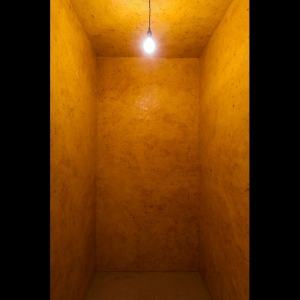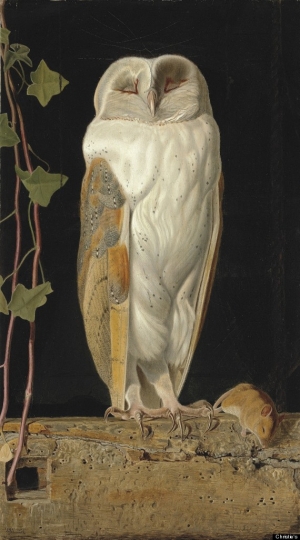|
Displaying items by tag: Art Critic
The program for the 56th edition of the Venice Biennale was revealed today by its curator, Okwui Enwezor, and Paolo Baratta, the organization’s president, at a conference at the Biennale headquarters at Ca’ Giustinian.
Enwezor, a curator, writer, critic and director of Munich’s Haus der Kunst since 2011, has given the biennial the title “All the World’s Futures.” The event, which opens to the public on 9 May and runs until 22 November, promises to be critically engaged with the events of today.
A very large painting by Guercino has been stolen from San Vincenzo church in Modena, Italy, the Agence France-Presse reports. The 1639 painting measures more than 9 feet tall and 6 feet wide, and depicts Mary accompanied by John the Evangelist and Saint Gregory. According to Italian art critic Vittorio Sgarbi, it is worth between €5–6 million ($6.7–8 million). The work was last seen around mid-day on August 10, a member of the church told the AFP.
“It’s an altarpiece with a magnificently dressed Saint Gregory,” Sgarbi told the AFP, “a monumental work from the first phase of the artist’s mature period.”

Deborah Solomon has been desperately trying to outrun the truth ever since American Mirror, her biography of my grandfather, Norman Rockwell, came out last November. But the truth is catching up with her.
Solomon's biography is one of the biggest non-fiction literary snow jobs in the last 50 years -- it makes the James Frey memoir debacle look like child's play. At least Frey took liberties by embellishing his own life, not defaming one of America's most beloved painters. Deborah Solomon doesn't just bend the truth, she breaks it. Many people are aware of the controversy, but few know and understand how Solomon has falsified almost every source she could get her hands on. This is not about differing opinions -- this is about an art critic who went out of her way to falsify, misquote, omit, distort and mischaracterize news stories, obituaries, my grandfather's autobiography (My Adventures As An Illustrator), his journal, my grandmother's letters, an insurance letter, a New Yorker article, and many other sources.
According to Italian art critic and former undersecretary of cultural heritage Vittorio Sgarbi, writing in Corriere della Sera‘s magazine Sette, a painting currently attributed to the followers of 16th-century Florentine painter Giuliano Bugiardini may actually be by Raphael. The portrait of an unknown woman was snapped up by collector Peter Silverman at Dorotheum in Vienna on April 9 for €36,900 ($50,000), well over its €15,000–20,000 estimate ($20,000–27,000), and now he is trying to have its attribution changed to the master from Urbino, Le Figaro reports.
“Vittorio Sgarbi is the first to suggest an attribution to the master, Silverman says. Now I’m going to let the experts have their say and see if a consensus emerges. For my part, all that I can say with certainty is that my wife and I are very happy to own this magnificent portrait.”
The art critic Robert Hughes described Goya's Disasters of War etchings as the greatest anti-war manifesto in the history of art. It is fitting, then, that as the world prepares to mark the 70th anniversary of the D-day landings and 100 years since the start of the 1914-18 war, 15 of these Goya prints will form the centrepiece of a powerful exhibition opening on Wednesday at the Louvre's outpost in Lens, a depressed former mining town flattened in the bombings of the first world war.
The exhibition's curator, the art historian Laurence Bertrand Dorléac, claims, however, that The Disasters of War: 1800 to 2014 is not pacifist.
Artists Gillian Wearing from the UK, Pierre Huyghe from France, Manfred Pernice from Germany, Willem de Rooij from the Netherlands, and Anri Sala from Albania and France have been shortlisted for the Vincent Van Gogh Biennial Award and stand to win €50,000 when the winner is announced on November 21. The contemporary art award will promote much-needed unity in the European Union, according to the head of the Hague’s Gemeentemuseum.

England’s Ashmolean Museum has acquired one of the most important Pre-Raphaelite paintings remaining in private hands. John Everett Millais’ (1829-1896) portrait of John Ruskin, the leading English art critic of the Victorian era, has been on loan to the institution since January 2012. The work was officially given to the museum by the Art Council England under the Acceptance in Lieu of Inheritance plan, which stipulates that under British tax law debts can be written off in exchange for objects of national significance. The painting recently appeared in Tate Britain’s highly successful exhibition Pre-Raphaelites: Victorian Avant-Garde.
Millais, one of the founders of the Pre-Raphaelite brotherhood, was commissioned to paint the portrait in 1853 by Ruskin himself. While working on the painting, Milliais fell in love with Ruskin’s wife, which ultimately led to the breakdown of the Ruskins’ marriage, Millais’ friendship with Ruskin, and the artist’s involvement with the Pre-Raphaelite movement. After marrying Ruskin’s wife, Effie, Millais gave the portrait to a friend in Oxford, Henry Wentworth Acland. The portrait remained in Acland’s family until his descendants sold it at Christie’s in 1965, where the late owner of the painting purchased it.
The Pre-Raphaelite Brotherhood, which formed in 1848, was a group of English painters, poets, and critics who rejected the traditional approaches to art and painting established by the Mannerist artists who succeeded Raphael (1483-1520) and Michelangelo (1473-1564). Instead, the Pre-Raphaelites turned to medieval and early Renaissance art for inspiration often painting subjects from Shakespeare and the Bible. Pre-Raphaelitism, which rattled Britain from 1848 to 1900, was considered the country’s first avant-garde movement.

Christie’s Post-War and Contemporary Evening Art Auction on May 15, 2013 in New York garnered $495 million – the highest total in auction history. Packed with masterpieces from an array of important art movements including Abstract Expressionism and Pop, many of the works offered were from lauded private collections and institutions. Brett Gorvy, Chairman and International Head of Post-War and Contemporary Art, said, “The remarkable bidding and record prices set reflect a new era in the art market, wherin seasoned collectors and new bidders compete at the highest level within a global market.”
The top lot of the night was Jackson Pollock’s (1912-1956) Number 19, 1948 (estimate: $25 million - $35 million). A prime example of Pollock’s drip paintings, the work sold for $58.3 million and set the record for the artist at auction. The influential art critic, Clement Greenberg, singled our Number 19 as the painting that offered enough proof to justify calling Pollock one of the most significant painters of our time.
Other highlights include Roy Lichtenstein’s (1923-1997) iconic work of pop art, Woman with Flowered Hat (1963) (estimate: approximately $30 million), which sold for $56.1 million and set the record for the artist at auction; Jean Michel-Basquiat’s (1960-1988) Dustheads (estimate: $25 million - $35 million), a neo-expressionist work from the 1980s, which sold for $48.8 million, an auction record for the artist; and Mark Rothko’s (1903-1970) color field painting, Untitled (Black on Maroon) (1958) (estimate: $15 million-$20 million), which sold for $27 million.
Out of 70 works offered at last night’s auction, only 4 failed to find buyers.

The Phillips Collection in Washington, D.C. will unveil its first permanent installation in over 50 years. Founded by the art collector and critic Duncan Phillips (1886-1966) in 1921, the Phillips Collection is the United States’ first modern art museum.
The new addition to the institution is a room made entirely from beeswax titled Wax Room. The experimental piece is the work of Wolfgang Laib (b. 1950), a conceptual German artist who is well known for his sculptural works made from natural materials. Laib has been making his beeswax chambers for over 25 years using hundreds of pounds of melted beeswax to coat walls and ceilings. The otherworldly spaces he creates are warmly lit by single hanging light bulbs.
The Phillips Collection’s other permanent installation is its Rothko Room, which holds four paintings by the abstract expressionist painter Mark Rothko (1903-1970). The intimate presentation of Rothko’s works was added as a permanent exhibit in 1960, six years before Duncan Phillips’ death. Phillips worked closely with Rothko, deciding which walls to hang each painting on and the kind of lighting and furniture that would best suit the room. The Phillips Collection was the first American museum to dedicate a space to Rothko’s work and it remains the only one designed in collaboration with the artist himself.
Laib’s progressive work is a welcomed addition to the Phillips Collection. While Phillips’ holdings consisted of many Impressionist paintings and other mainstream works, he also had a taste for the unconventional. Phillips was one of the earliest patrons of American modernists including John Marin (1870-1953) and Arthur Dove (1880-1946) and also harbored great admiration for Abstract Expressionism before it became a respected art movement.
Laib’s Wax Room will be unveiled on March 2, 2013.

When Jane Cordery, an art teacher in Hampshire, England discovered a portrait of a white owl in her attic, she was struck by the painting’s sophisticated brushwork. Upon her unearthing, Cordery decided to email a photo of the work to Christie’s in London.
The auction house determined that the painting, titled The White Owl (1856) was the work of pre-Raphaelite artist William James Webbe (fluent 1953-1878) and valued the painting at $113,449. Further research proved that The White Owl had been exhibited at the United Kingdom’s Royal Society during the mid-nineteenth century. It was here that famed art critic, John Ruskin, viewed the work and remarked on its painstaking composition.
The Webbe painting headed to Christie’s Victorian art sale last week and sold for $951,050, exceeding its estimated price and setting the record for the artist at auction. An anonymous British dealer purchased The White Owl at the Christie’s sale. While Cordery claims she had never seen the painting before, her partner said that he received the work as a gift from his mother.
|
|
|
|
|